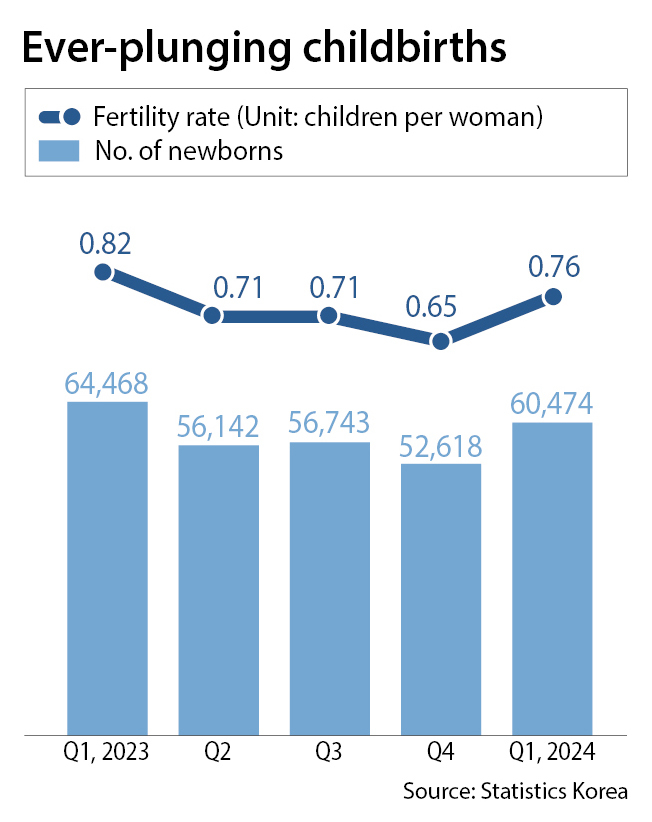Korea's fertility rate hits new first-quarter low as baby dearth continues
![A public sculpture installed in Daegu is decorated with tears and a sinking ship with last year's record low fertility rate of 0.72 written on it, as part of a campaign to raise public awareness of tplunging childbirths, on March 17. [YONHAP]](https://koreajoongangdaily.joins.com/data/photo/2024/05/30/41834142-de12-439b-a3f4-a2edc2530106.jpg)
A public sculpture installed in Daegu is decorated with tears and a sinking ship with last year's record low fertility rate of 0.72 written on it, as part of a campaign to raise public awareness of tplunging childbirths, on March 17. [YONHAP]
Korea’s fertility rate plunged to yet another fresh low of 0.76 in the first quarter, breaching the 0.8 threshold for the first time in the January-March period.
As childbirths tend to be the highest in the first quarter, the figure is expected to plummet further through the rest of the year.
According to Statistics Korea Wednesday, the number of newborns in March declined by 7.3 percent from the same period last year to 19,669, falling below the 20,000 mark for the first time in March. The figure saw an on-year decline for the 17th consecutive month.
The crude birthrate — the average number of births per 1,000 populations — came in at 4.5 children, down 0.3 from a year prior.
It brings the total number of newborn babies in the first quarter to a record low of 60,474, with an on-year decrease of 6.2 percent.

The total fertility rate — the average number of children expected to be born per woman over her lifetime — came in at 0.76, down by 0.06 from last year. The replacement fertility rate, or the minimum figure needed to maintain a stable population without immigration, is estimated at 2.1 births per woman.
It is the first time the first-quarter figure fell below the 0.8 mark, as the January-March period tends to see the highest number of newborns in the country.
The fertility rate decreased across all 17 administrative regions in Korea.
As the number of deaths nationwide rose 7.6 percent to 31,160 in March, Korea’s population shrank by a net of 11,491. It marked 53 straight months of net population decline.
On a quarterly basis, the number of deaths rose 5.2 percent to 93,626, resulting in a net population decline of 33,152, or 2.7 percent.
The population in all regions except Sejong declined from the same period a year earlier. Sejong saw a net increase of 3.8 percent.
Notably, the drop in the fertility rate was the steepest among women aged between 30 and 34.
In the January-March period, 72.3 babies were born from every 1,000 women in the age bracket, down by 4.4 from last year. The figure was 45.9 for women aged between 35 and 39, also down from 48.9 babies a year earlier, and 21.5 for those aged between 25 and 29, down by 2.3.
The statistics agency expects this year's fertility rate to come at 0.68.
Last year, the total fertility rate stood at 0.72, a record low. The quarterly fertility rate steadily declined through 2023, from 0.82 in the first quarter and 0.71 in the second and third, to the lowest-ever of 0.65 in the fourth.
BY SHIN HA-NEE [shin.hanee@joongang.co.kr]










with the Korea JoongAng Daily
To write comments, please log in to one of the accounts.
Standards Board Policy (0/250자)